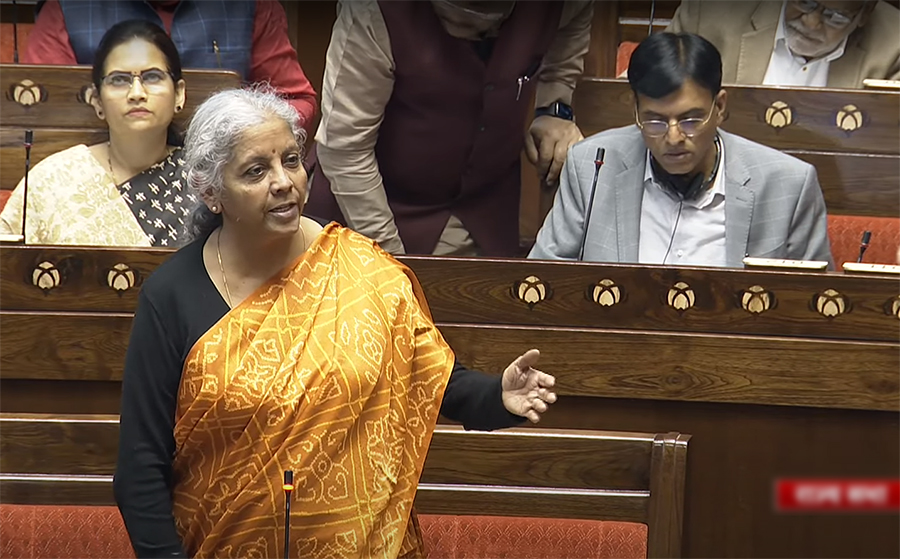The paper said that in an era where capital flows dominate, India’s external vulnerability shot up because of over-dependence on external commercial borrowings (ECB)…reports Asian Lite News
Noting that the UPA government inherited a healthy economy but made it “non-performing” in its 10 years, the White Paper brought out by the Finance Ministry states that the Modi government has bolstered macroeconomic foundations, revitalised financial sector, overhauled the credit ecosystem and transformed the quality of India’s infrastructure.
The White Paper, tabled in Parliament by Finance Minister Nirmala Sitharaman on Thursday during the budget session, the last session ahead of Lok Sabha elections expected in April-May this year, compared the economic performance of 10 years of the Congress-led UPA government with that of the BJP-led government headed by Prime Minister Narendra Modi.
It said the UPA government’s economic and fiscal mismanagement “had ultimately hollowed the growth potential of India by the end of its term.”
“Since the time our government assumed power in 2014, the Indian economy has undergone many structural reforms that have strengthened the macroeconomic fundamentals of the economy. These reforms resulted in the transition of India from the league of ‘Fragile Five’ to the league of ‘Top Five’ in just about a decade as the economy was transformed into a far more resilient avatar amidst a challenging global environment,” the paper said.
“In the past ten years, the government has revitalised the stagnant financial sector and overhauled the credit ecosystem within the economy, bringing about significant improvements,” it added.
The paper said that the UPA government inherited a healthy economy ready for more reforms, but made it non-performing in its 10 years and that the UPA leadership, “which seldom fails to take credit for the 1991 reforms,” abandoned them after coming to power in 2004.
“The UPA government, in its quest to maintain high economic growth by any means after the global financial crisis of 2008, severely undermined the macroeconomic foundations. One such foundation that was severely weakened by the UPA government was price stability,” it said.
“The banking crisis was one of the most important and infamous legacies of the UPA government. The banking crisis in 2014 was massive, and the absolute sum at stake was too large. Gross advances by public sector banks were only Rs 6.6 lakh crore in March 2004. In March 2012, it was Rs 39.0 lakh crore. Further, not all problem loans were recognised…
“There was much under the hood. According to a Credit Suisse report published in March 2014, the top 200 companies with an interest coverage ratio of less than one owed about Rs8.6 lakh crore to banks. Nearly 44 per cent of those loans (Rs 3.8 lakh crore) were yet to be recognised as problem assets. That alone would have added another 6.7 per cent to the GNPA ratio,” it added.
The paper said that in an era where capital flows dominate, India’s external vulnerability shot up because of over-dependence on external commercial borrowings (ECB).
“The UPA government had compromised external and macroeconomic stability, and the currency plunged in 2013. From its high to low, against the US dollar between 2011 and 2013, the Indian rupee plunged 36 per cent. The famous Foreign Currency Non-Resident (FCNR(B)) deposit window for NRIs was actually a call for help when there was a large depletion of the foreign exchange reserves.” (ANI)
Cong releases ‘black paper’
The Congress on Thursday (February 8) released a black paper on the Narendra Modi government’s failures, highlighting economic, social and political injustices in the last ten years.
The 54-page document, titled “10 Saal Anyay Kal”, released by Congress president Mallikarjun Kharge at a press conference in the national capital, claims that the Modi government in its ten years in power has “devastated the country’s economy, aggravated unemployment, destroyed the country’s agricultural sector, abetted crimes against women and committed grave injustices against minorities in the country”.
“Today we are bringing out a ‘Black Paper’ against the government. Whenever PM Modi presents his views in Parliament, he hides his failures. At the same time, when we speak about the failures of the government, it is not given importance. Therefore, we want to bring out a Black Paper and tell the public about the failures of the government,” said Kharge.
The move to release the “black paper” comes amid speculation that the Modi government will bring a white paper in parliament to highlight the economic failures of the UPA between 2004 and 2014.
Speaking in the Lok Sabha on Wednesday, BJP MP Jayant Sinha, who is also the member of the Standing Committee on Finance, said that a white paper will be brought to the house.
“India’s GDP growth had slowed down to 5%, inflation had risen to 10%, The country was facing a balance of payment crisis. The baking system was in a crisis. Everyone was leaving the country and we were in the fragile economies in the world. This is the condition in which the UPA had left us,” he said in his remarks on the interim budget.
“In the white paper, we will clarify what was the position of the economy (before 2014) … and how we have tackled the economic problems.”
The ongoing interim budget session of parliament which was slated to end on Friday has also been extended by a day to Saturday, when the white paper is likely to be presented.
ALSO READ-Netanyahu Asserts No Plan for Permanent Occupation of Gaza

